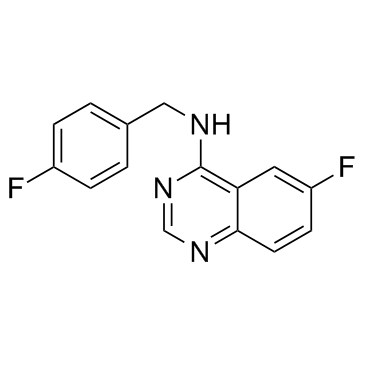Spautin-1

Spautin-1 structure
|
Common Name | Spautin-1 | ||
|---|---|---|---|---|
| CAS Number | 1262888-28-7 | Molecular Weight | 271.265 | |
| Density | 1.4±0.1 g/cm3 | Boiling Point | 419.6±40.0 °C at 760 mmHg | |
| Molecular Formula | C15H11F2N3 | Melting Point | N/A | |
| MSDS | Chinese USA | Flash Point | 207.6±27.3 °C | |
| Symbol |


GHS05, GHS07 |
Signal Word | Danger | |
|
Single Chain Variable Fragments Produced in Escherichia coli against Heat-Labile and Heat-Stable Toxins from Enterotoxigenic E. coli.
PLoS ONE 10 , e0131484, (2015) Diarrhea is a prevalent pathological condition frequently associated to the colonization of the small intestine by enterotoxigenic Escherichia coli (ETEC) strains, known to be endemic in developing countries. These strains can produce two enterotoxins associa... |
|
|
Photosynthetic production of enantioselective biocatalysts.
Microb. Cell Fact. 14 , 53, (2015) Global resource depletion poses a dramatic threat to our society and creates a strong demand for alternative resources that do not compete with the production of food. Meeting this challenge requires a thorough rethinking of all steps of the value chain regar... |
|
|
Outer-membrane translocation of bulky small molecules by passive diffusion.
Proc. Natl. Acad. Sci. U. S. A. 112 , E2991-9, (2015) The outer membrane (OM) of gram-negative bacteria forms a protective layer around the cell that serves as a permeability barrier to prevent unrestricted access of noxious substances. The permeability barrier of the OM results partly from the limited pore diam... |
|
|
Effects of pre- and postnatal exposure to flutamide on connexin 43 expression in testes and ovaries of prepubertal pigs.
Eur. J. Histochem. 54(2) , e15, (2010) The aim of this study was to show whether the connexin43 (Cx43) expression in gonads is affected by an anti-androgen action. To test this, pigs were prenatally (on gestational days 20-28 and 80-88; GD20, GD80), and postnatally (on days 2-10 after birth; PD2) ... |
|
|
Cellulose Microfibril Formation by Surface-Tethered Cellulose Synthase Enzymes.
ACS Nano 10 , 1896-907, (2016) Cellulose microfibrils are pseudocrystalline arrays of cellulose chains that are synthesized by cellulose synthases. The enzymes are organized into large membrane-embedded complexes in which each enzyme likely synthesizes and secretes a β-(1→4) glucan. The re... |
|
|
Expression and purification of Z protein from Junín virus.
J. Biomed. Biotechnol. 2010 , 970491, (2010) Arenaviridae comprises 23 recognized virus species with a bipartite ssRNA genome and an ambisense coding strategy. The virions are enveloped and include nonequimolar amounts of each genomic RNA species, designated L and S, coding for four ORFs (N, GPC, L, and... |
|
|
Electrochemical disinfection of dental implants--a proof of concept.
PLoS ONE 6 , e16157, (2011) Peri-implantitis has gained significant clinical attention in recent years. This disease is an inflammatory reaction to microorganisms around dental implants. Due to the limited accessibility, non-invasive antimicrobial strategies are of high interest. An une... |
|
|
Chondroitin Lyase from a Marine Arthrobacter sp. MAT3885 for the Production of Chondroitin Sulfate Disaccharides.
Mar. Biotechnol. 17 , 479-92, (2015) Chondroitin sulfate (CS) saccharides from cartilage tissues have potential application in medicine or as dietary supplements due to their therapeutic bioactivities. Studies have shown that depolymerized CS saccharides may display enhanced bioactivity. The obj... |
|
|
Photo-induced proton gradients for the in vitro investigation of bacterial efflux pumps.
Sci. Rep. 2 , 306, (2012) We describe an original activity assay for membrane transport that uses the proton motive force-dependent efflux pump MexAB from Pseudomonas aeruginosa. This pump is co-reconstituted into proteoliposomes together with bacteriorhodopsin (BR), a light-activated... |
|
|
Expression and purification of functional human mu opioid receptor from E.coli.
PLoS ONE 8 , e56500, (2013) N-terminally his-tagged human mu opioid receptor, a G protein-coupled receptor was produced in E.coli employing synthetic codon-usage optimized constructs. The receptor was expressed in inclusion bodies and membrane-inserted in different E.coli strains. By op... |